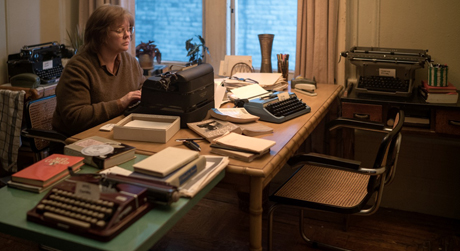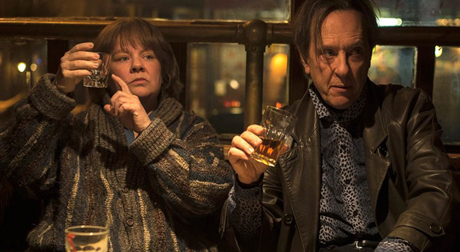
In 1961, journalist and activist Jane Jacobs published The Death and Life of Great American Cities, a groundbreaking work arguing that urban spaces flourish when meaningful human relationships are structurally nurtured.[i] In 1999, novelist and critic Samuel R. Delany revitalized Jacobs’ ideas on interconnectedness through his essay collection Times Square Red, Times Square Blue, which intimately explores the physical, mental and emotional bonds forged within many now defunct queer communal hubs during the height of the AIDS crisis.[ii] These texts laid the groundwork for Marielle Heller’s 2018 film Can You Ever Forgive Me?, a love letter to the unlikely and unspoken affinities between queer outsiders, loners and survivors in New York City during the early nineties. Yet the fragile connections formed in Can You Ever Forgive Me? never lead to redemption or happy endings. Rather, echoing Jack Halberstam’s theory of queer failure, Heller excavates deeper in order to explore how her outsiders’ failures, mistakes and fakes “offer more creative, more cooperative, more surprising ways of being in the world.”[iii]
Can You Ever Forgive Me? is the story of real-life celebrity biographer Leonore “Lee” Israel, a poverty-stricken former New York Times bestselling biographer who turns to literary forgery as a means to survive. Lee, played by Melissa McCarthy, is an irascible writer with a drinking problem. At the outset of the film she is fired from a copy job, alienates her literary agent with her erratic behavior, and faces eviction due to months of unpaid rent. Her descent into economic precarity is ruthless—as the actual Lee Israel recalled in her 2008 memoir, “over a period of three years, I plummeted from best-sellerdom to welfare.”[iv]
Echoing Jack Halberstam’s theory of queer failure, Heller excavates deeper in order to explore how her outsiders’ failures, mistakes and fakes “offer more creative, more cooperative, more surprising ways of being in the world.”
The market is not kind to the vulnerable, and Lee is vulnerable because she is alone. In lieu of a community, Heller initially positions Lee in relation to people who can only react to her rough edges—she is a hard, rude, disagreeable and difficult individual. For a middle-aged gay woman struggling to survive, such traits can be death knells, but Heller’s lens renders the writer as a worthy subject precisely because of these flaws, methodically centering her missteps as she ascends through the world of forgery. Lee’s uncanny talent for fraud blurs the boundaries between success and failure, building on Halberstam’s assertion that success “in a hetero-normative, capitalist society equates too easily to specific forms of reproductive maturity and wealth accumulation.”[v]
In contrast to the cruelties of such systems, Heller and Halberstam position queerness and queer community as avenues to humane, ultimately enriching existence. The bumpy narrative arc of Can You Ever Forgive Me?’s protagonist reveals that success and happiness are neither clear-cut nor continuous; rather, Lee’s upsets and flaws allow her to grow into herself and her chosen community. Her queer identity is critical to this process of self-discovery, inasmuch as her ability to develop in tandem with uncomfortable and difficult moments depends on her location within larger webs of explicit and implied queer relationships: the prominent queer figures she writes about and mimics; her romantic relationships; and her friendships. By exploring each of Lee’s networks as sites of potential and transformation, we uncover the radical power of the film’s subterranean intimacies.
Heller uses the personal ephemera of prominent queer cultural figures to bookend Lee’s journey in literary letters. After learning that her beloved cat is in dire need of several expensive medical procedures, Lee is forced to sell one of her prized belongings: a signed, sentimental letter by actress Katharine Hepburn. To understand the significance of this letter, we need look no further than Israel’s real-life 1967 profile of Hepburn for Esquire magazine. The article is rife with queer allusions and subtext: Hepburn critiques “the idiotic way women are… forced to dress;” she speaks of her attempts to evade public scrutiny, and of “leading the kind of personal life that would be sort of titillating to the public;” Laura Harding, described as one of Hepburn’s “closest friends,” appears and reappears throughout the text.[vi] Overall, the profile conveys a sense of admiration for an uncompromising individual blazing an unconventional trail. Hepburn, though a wealthy actor, clearly chaffs at the restrictions imposed by society,[vii] and it’s easy to imagine both Israel and the character of Lee feeling a kinship with her in this regard. In selling her Hepburn letter, Lee severs a bond with an (invisible) queer icon while simultaneously leveraging the connection to ensure her survival.
Invigorated by the profitable Hepburn sale, Lee begins to craft her forgeries, finding unexpected artistic fulfillment in the scam. Her skill at mimicry turns out to be a highly lucrative asset, and for a time she is able to experience the joys of thriving as a writer. But failure proves inevitable—when she unthinkingly outs a celebrity, she reveals herself. Lee’s downfall is precipitated by a faked Noël Coward letter containing an admiring remark for a nameless male lover’s physique. The line raises questions with sellers, as Coward was notoriously evasive about his sexual life in his personal communications, choosing instead to express explicit and coded queer desire through his playwriting. Critics cite the autobiographical and intimate nature of plays such as Song at Twilight (1966), in which an aging author’s former mistress confronts him: ”Homosexual tendencies in the past? You’re as queer as a coot and you have been all your life!”[viii] Though it may be tempting to read the line as a declaration from Coward, such an interpretation is too simplistic. Sexuality is an ever-evolving spectrum—desire, creative output and selfhood all contain contradictions and coexist in perpetual tension and renegotiation. As Israel stated in her autobiography, “I still consider the letters to be my best work . . . I was a better writer as a forger.”[ix] To get at the truth of this statement – that she rediscovered her voice and passion through the voices of others—we must recognize the fluidity and porousness of the relations between authenticity, personal growth and “faking it.”

In selling her Katharine Hepburn letter, Lee severs a bond with an (invisible) queer icon while simultaneously leveraging the connection to ensure her survival.
Can You Ever Forgive Me?’s playful yet painful breach of the boundary between authenticity and dishonesty is mirrored in the film’s portrayal of Lee’s romantic relationships, which consist of late-night crank calls to a former lover and an unsuccessful attempt to woo a charming bookseller named Anna (Dolly Wells), who purchases Lee’s forgeries. The bond formed by the two women as a result of their shared love of literature presents Lee with unspoken opportunities. Close-up and medium shots frame their early bookstore interactions with erotic potential: Lee’s life may change; her isolation may dissolve; love may become slightly less opaque. Anna asks Lee to dinner. Lee’s eyes widen in surprise, but she accepts.
Their date is both crushingly lovely and bittersweet. Anna self-consciously gives Lee a few of her own short stories, requesting she read them and share her thoughts. Lee gently accepts: “I’m honored.” Something silent and delicate passes between the women, making them seem like two shy girls unsteady with first love. When Anna reaches into her handbag for her reading glasses, Lee’s face breaks open with tenderness and longing. She nervously gulps glass after glass of wine, commenting with forced joviality that she always “needs a drinking buddy;” Anna’s face falls at this platonic suggestion and both women silently resume drinking, avoiding each other’s gaze. Leaving the restaurant, Lee is unable to cope with the fact that the woman she desires is also the woman she has lied to. She stonily cuts the evening short, leaving Anna stunned.
The scene is a heartbreaking but honest look at Lee’s self-sabotaging behavior. It would be disingenuous to ignore her role in manufacturing her own unhappiness. Her curt dismissal is not a gesture of self-sacrifice—she is not sparing Anna—it is a selfish act born out of fear. Lee is not a queer champion, she is a person who cheats to get ahead and fumbles her attempts at love. But the audience is invited to love her not in spite of these traits but because of them, echoing Halberstam’s argument that mistakes and regrets can be recognized “without the need for redemption.”[x]

Lee’s self-imposed isolation and difficulty connecting with people can be reconsidered with greater optimism using Delany’s theory of queer contact. Delany asserts that under capitalism, happiness can shine brightest in dim, out-of-the-way corners traversed with care[xi]—a definition that perfectly describes the setting of Lee’s friendship with Jack Hock (played by Richard E. Grant). The two social outcasts meet at Greenwich Village’s Julius’ bar, where Jack makes Lee laugh with witty stories of his city adventures. They quickly become close; Lee lets Jack live in her apartment after he is beaten up in a hustling deal gone sour. Grant crafts Jack as a sunny, open foil to Lee’s aloof, self-protective armour. In the face of his constant petitions for the two of them to “do something” because “life is DREAARY,” she begins to open up and care for him.
Eventually, she trusts Jack enough to let him in on the details of her forgery scam, even allowing him to assist in the selling process. After each successful sale, the duo celebrates their good fortune by treating themselves to a good meal and a night on the town. During one such evening, they head to an underground bar with an entrance that is hidden around the corner from the main thoroughfare. Inside its dark alcoves, the tables resemble velvet pockets and shadowy plumes of tobacco smoke envelop the patrons. Against the shine of the stage, small candles are strewn on surfaces like blooming flowers in a glen. Lee recites Jack’s order by memory to the waiter, insisting he get his preferred expensive cut of steak. Later that night, as a drag performer sings a jazzy rendition of Lou Reed’s “Good Night Ladies,” the camera focuses in on Lee’s face—completely at ease for the first time as she savours the song and the company.
It is through Lee’s self-sabotage and emotional isolation that her forgeries, and her friendship with Jack, can be understood as sentimental, profoundly human acts of care.
Disaster strikes soon after when she blames Jack for her cat’s death, banishing him from her home despite knowing he has nowhere else to live. Ignoring his protestations and apologies, she physically and emotionally shuts out her best friend and finds herself alone, once again. Her situation worsens as more sellers and buyers report her pieces as frauds to the authorities, who eventually rope Jack into assisting them in apprehending her. Jack agrees to help the FBI only on the condition that, post-arrest, Lee will have no access to him (no telephone calls, letters, etc.). The sting, which involves the sale of stolen, authentic letters by Lillian Hellman (whose 1934 play The Children’s Hour famously centers on a lesbian affair), is successful. Lee is summoned to court, where she receives a probationary sentence after speaking candidly about her lack of remorse for the forgeries and her willingness to accept punishment.

Several months later, she runs into Jack for the first time since their falling out. Surprisingly, he welcomes her with a few well-timed insults. Lee returns the favor, and they share a chuckle at their barbed rapport. He hints at new health issues, the threat of HIV and AIDS lurking in the background alongside the ways in which they have failed each other as friends. They say nothing further, for what can be said? Their camaraderie rebuffs probation, homelessness and death. Who is to say that the simplicity of an insult and shared drink means less than a hackneyed lap in a winner’s circle?
Lee leaves the bar and we see her at home, writing with a new kitten. Her newfound sense of peace is not a sign of redemption—she did not need to be saved. Rather, she has learned from and accepted her mistakes, failures and flaws through her attempts to connect with others. Heller’s ode to queer personhood and community—and vulnerability, mortality and resilience—under persecution is an urgent call for connection under late stage capitalism. Lee’s story sharpens a quiet joy and humanity from her shortcomings and missteps, elevating the writer and her faked letters to works of art. It is through Lee’s self-sabotage and emotional isolation that her forgeries, and her friendship with Jack, can be understood as sentimental, profoundly human acts of care.





